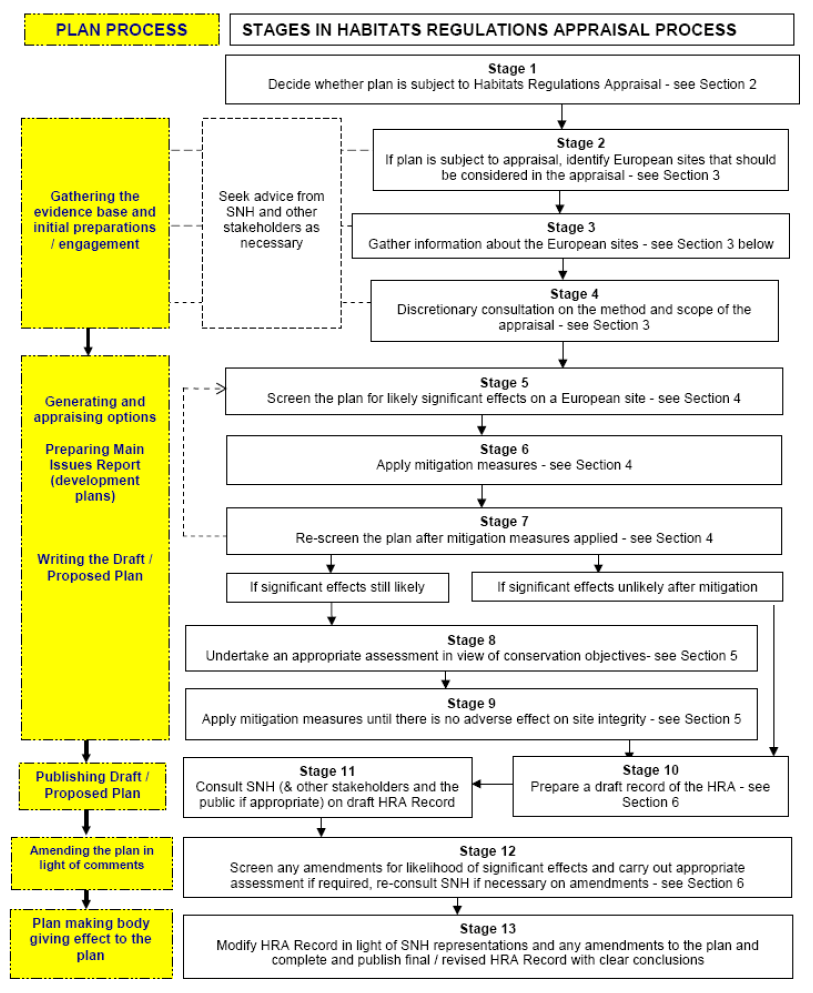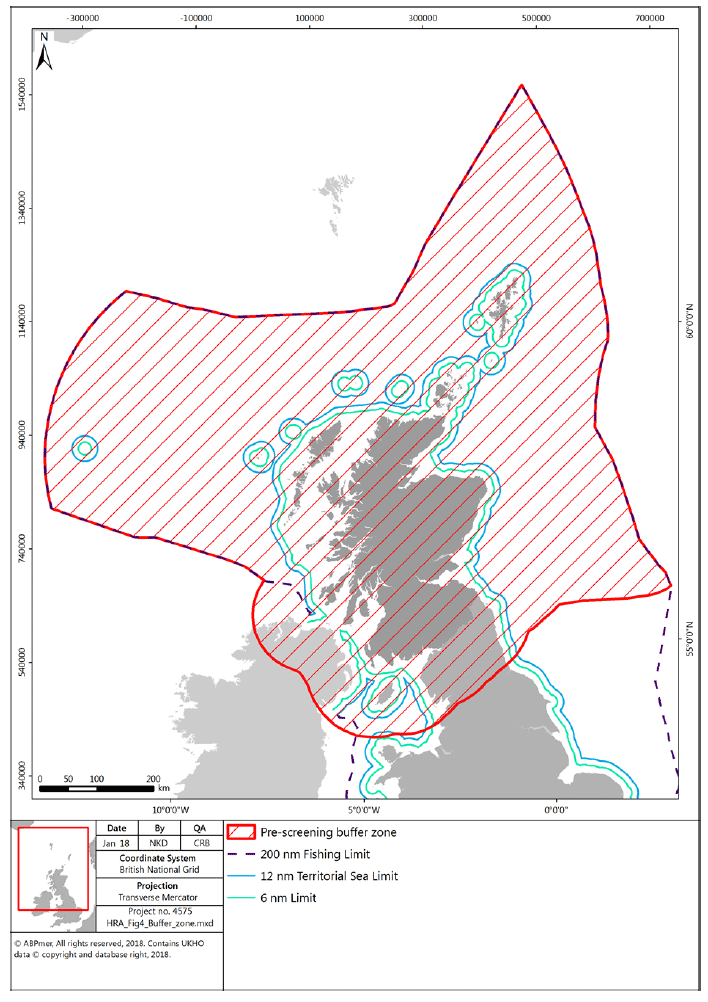Sectoral marine plan for offshore wind energy: strategic habitat regulations appraisal pre-screening report
Results of the pre-screening stages of the habitat regulations appraisal.
2 Approach to HRA
2.1 Legislative Context
2.1.1 The requirements of the EC Habitats and Birds Directives are transposed in Scotland to the limit of ‘inshore’ waters at 12 nm from the territorial baseline through a combination of the Conservation of Habitats and Species Regulations 2010 (in relation to reserved matters) and the Conservation (Natural Habitats, &c.) Regulations 1994 (as amended). Beyond this, in the ‘offshore’ zone, which lies between 12 and 200 nm, the UK Government has authority and the Offshore Marine Conservation (Natural Habitats, &c.) Regulations 2007 (as amended) are in force. Within this document these are collectively referred to as the ‘Habitats Regulations’.
2.1.2 Under the Habitats Regulations, where a plan or project is not directly connected with or necessary for the management of European sites, and where the possibility of a ‘Likely Significant Effect’ ( LSE) on these sites cannot be excluded, either alone or in combination with other plans or projects, an Appropriate Assessment ( AA) should be undertaken.
2.1.3 This assessment is made against the European sites’ Conservation Objectives by the Competent Authority.
2.1.4 These sites include the following which comprise the Natura 2000 network:
- Special Areas of Conservation ( SACs) designated under the EC Directive on the Conservation of Natural Habitats and of Wild Fauna & Fauna (the Habitats Directive); and
- Special Protection Areas ( SPAs) sites classified under the EC Directive on the Conservation of Wild Birds (the Birds Directive).
2.1.5 In the UK these requirements are also extended to the consideration of effects on:
- Ramsar Sites [4] (listed under the Ramsar Convention on Wetlands of International Importance); and
- Sites that are proposed for designation and inclusion in the Natura 2000 network and those sites that are currently in the process of being classified such as: potential SPAs ( pSPAs), candidate and possible SACs ( cSACs and pSACs) and Sites of Community Importance ( SCIs [5] ).
2.1.6 This would also include any proposed extensions or additions to existing European sites.
2.1.7 In recognition of the range of designated/proposed sites that are protected by law under the Habitats Regulations, or by Government policy, these sites are simply and collectively referred to throughout this document as European/Ramsar sites.
2.1.8 As Competent Authority, Marine Scotland is responsible for producing an AA that assesses the impacts of the draft Plan on these sites in fulfilment of the Habitats Regulations obligations. The Competent Authority can adopt the Plan only after having ascertained that it will not adversely affect the integrity of the European/Ramsar sites concerned.
2.1.9 If it is concluded that the Plan will have an adverse effect on integrity ( AEOI) on a European/Ramsar site (either alone or in combination with other plans or projects), the Plan can only be adopted if it has been ascertained that there are no alternative solutions and it is necessary for Imperative Reasons of Overriding Public Interest ( IROPI), including those of a social or economic nature. In these circumstances, before such a plan can proceed, compensatory measures must be secured to ensure that the overall coherence of the network of Natura 2000 sites is maintained.
2.2 Adherence to Key Guidance
2.2.1 The approach that has been followed for this HRA draws especially on the agreed SNH guidance for undertaking plan-level HRAs in Scotland (David Tyldesley and Associates, 2015) which divides the whole process into 13 distinct stages as shown in Figure 4. It has also taken account of the guidance produced by the European Commission on the ‘Assessment of plans and projects significantly affecting Natura 2000 sites’ (European Commission, 2001).
2.2.2 In this way, the HRA has been carried out in an iterative, auditable and transparent manner. This is to provide as much clarity as possible in the process and also to ensure that the relevant documentation can be readily accessed, interpreted and interrogated.
Figure 4: Key stages of plan-level HRA process for plans

Source: David Tyldesley and Associates (2015).
2.3 Building on Previous Plan-level HRAs
2.3.1 The methods followed in the initial pre-screening stages of the HRA and proposed for the subsequent stages of the HRA, have built on the lessons learned from and approaches taken during previous ‘case example’ plan-level HRAs. Almost all of these plans have followed similar standard principles for plan-level HRA based around the 13-step process shown in Figure 4.
2.3.2 These ‘case examples’ include HRAs of the following plans:
- Draft Sectoral Marine Plans for Offshore Renewable Energy in Scottish waters (ABPmer, 2017);
- Northern Ireland marine plan ( AECOM and ABPmer, 2017);
- Marine Renewables Infrastructure Plan (ABPmer, 2015);
- English South marine plans ( MMO, 2015);
- Irish Scottish Links on Energy ( ISLES) Spatial Plan ( AECOM and ABPmer, 2015);
- The Crown Estate’s Wave and Tidal Further Leasing (W&TL) plan (ABPmer, 2014);
- The Crown Estate’s Offshore Floating Wind Test Sites plan ( AMEC, 2013; 2014);
- Draft Plan for Wave and Tidal Energy in Scottish Waters (ABPmer, 2013);
- English East marine plans ( MMO, 2013);
- Draft Plan for Offshore Wind Energy ( OWE) in Scottish Waters (ABPmer, 2011a);
- National Infrastructure Renewables Plan ( N-RIP) (ABPmer, 2011b);
- Northern Ireland Offshore Renewable Energy Strategic Plan ( ORESAP) 2009-2020 (Entec, 2011);
- Offshore Renewable Energy Development Plan ( OREDP) for Ireland ( AECOM, 2011);
- Pentland Firth Strategic Area ( PFSA) Leasing Round (ABPmer, 2010a; b); and
- Round 3 Offshore Wind Farm Plan (Entec, 2009a; b).
2.4 Scope of Pre-screening
2.4.1 This report presents the approach taken and results obtained for the initial ‘pre-screening’ stages of the HRA (Stages 1 to 4 of the SNH guidance, see Figure 4).
2.4.2 One of the main purposes of the initial pre-screening stages is to be a first sifting stage of the HRA process whereby those sites and interest features for which there is a potential for a LSE (or where such a LSE cannot be excluded) are broadly identified and taken forward into the screening and assessment stages of the HRA.
2.4.3 In making the judgement about LSE (both here and later at the screening phase), interlinked factors need to be considered such as: the impacts arising from the Plan; the distance from the European/Ramsar sites or interest features; and current scientific understanding (and gaps in that understanding) about the ecology, behavioural characteristics and ‘sensitivities’ of the interest features. The impacts of the Plan either alone or in combination with other plans or projects also need to be considered. Information from past literature reviews and from the advice previously received from stakeholders as part of completed HRA work (see list in Section 2.3) has been taken into account to inform the pre-screening review.
2.4.4 The nature of the deployments within the Plan are not fully understood at this time and it is also likely that there will be new technological developments for the devices themselves, or associated infrastructure, in the future which cannot currently be foreseen. This may influence where they are located, how they are constructed and their size, all of which could have a bearing on their potential to cause a LSE on European/Ramsar sites and interest features. It is also the case that continued improvements in our understanding of environmental impacts may mean some sites become more or less suitable for development in the future.
2.4.5 The existing 200 nm fishery limit around Scotland plus a 100 km buffer south of the Scottish border has been applied in this HRA as a quantifiable and objective ‘pre-screening buffer zone’ (Figure 5). This pre-screening buffer zone captures many of the mobile interest features (fish, seabirds and marine mammals) within European/Ramsar sites that could be indirectly affected by the draft Plan. However, it has not been used to limit further review (in the subsequent stages of the HRA) of more distant locations or to presume that all relevant features within this area, for which impact pathways exists, are necessarily affected.
2.4.6 If more detail emerges about the Plan as the SA process progresses (e.g. possible cable alignments and cable landfall positions), then the HRA screening and subsequent assessment could be more focussed as appropriate. At this stage, the only assumption that has been made is that all development under the draft Plan will landfall in the UK. Landside infrastructure (including grid connection) falls outside the scope of the Plan and this HRA.
2.4.7 Another important purpose for the initial pre-screening is to set out the proposed methods for undertaking the subsequent screening and assessment stages of the HRA (Stage 4 of the plan-level HRA guidance). These methods, in particular, are presented so that they can be discussed and agreed with key stakeholders. For coastal and offshore plans, Stage 4 of the plan-level HRA guidance is often particularly vital as it sets the context for how the assessment progresses and how ultimately, it presents a clear and auditable mechanism for both the assessment conclusions and the future implementation of the plan.
Figure 5: Pre-screening buffer zone used to identify relevant European/Ramsar sites

2.5 Consideration of Uncertainties
2.5.1 A major consideration throughout the HRA process is that the draft Plan has inherent uncertainties associated with it. These uncertainties relate to several aspects such as: the detail of the Plan implementation process; future generation capacities; the location, scale and densities of development; the proposed technologies to be used; the scale of the effects arising via some of the defined impact pathways; and the efficacy of some project-level mitigation options.
2.5.2 In addition to the inherent uncertainties about the project details and the impacts arising from the Plan, there will be a high level of uncertainty associated with the future impacts which apply to other plans and projects. Such uncertainty about in-combination effects is typically a characteristic in all strategic coastal and offshore plans where the full extent of future developments cannot be anticipated.
2.5.3 Although these uncertainties exist, a high level of certainty is required under the Habitats Regulations that there will be no ‘adverse effect on integrity’ ( AEOI) of any European/Ramsar site. The HRA will therefore take account of these issues and, where required, identify relevant mitigation measures to accompany the Plan.
2.6 Precautionary Approach
2.6.1 A precautionary approach has been adopted in this HRA in order to ensure that no relevant sites or features are excluded. Also, full consideration has been given to the definitions and interpretations of the LSE judgement. Under the Habitats Regulations, LSE is defined as a more than ‘ de minimis’ change. In other words, a plan would not be considered to have a LSE on a European/Ramsar site if “ any potential effects are trivial, or ‘de minimis’ or so restricted or remote from the site that they would not undermine the conservation objectives for the site in combination” (David Tyldesley and Associates, 2015). For this pre-screening report no judgements about LSE were employed but the methods for the first LSE screening have been identified based on the understanding about the sensitive nature of this judgement and the need to ensure that during this screening the presumption is for including sites unless it is definitely clear that there is no LSE.
Contact
There is a problem
Thanks for your feedback